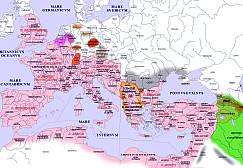

An Online Encyclopedia of Roman Emperors
Anastasius (AD 491-518)
Hugh Elton
Florida International University
Anastasius was born in Dyrrachium (modern Durazzo, in Albania), on the Adriatic coast, ca. 430. He was not prominent at the court of Zeno, reaching the minor rank of silentiary in the palace. His religious knowledge, however, meant he was considered in 488 for promotion to bishop of Antioch. After Zeno's death Anastasius was acclaimed as emperor 11 April, 491. Anastasius was the choice of Ariadne Zeno's widow, and seems to have been a surprise to the aristocracy. A month after his accession, Anastasius married Ariadne, on 20 May, 491, but the marriage produced no children. He was buried with Ariadne in the Church of the Holy Apostles in Constantinople. Anastasius was nicknamed "Dicorus" (Two-Pupils), because of his eyes (one black, one blue). He died 8/10 July, 518 and was succeeded by Justin.
After Zeno's death, his brother Longinus (from Isauria) had hoped to become Emperor. Anastasius exiled him to the Thebaid in Egypt and expelled other Isaurians from Constantinople. Other non-Isaurian officials were also removed. These actions provoked an Isaurian revolt. Although the main rebel army, led by Longinus of Cardala, was rapidly defeated in 491 at Cotyaeum in Phrygia, it was not until 498 that all the rebels were mopped up from their Isaurian strongholds.
In the Balkans, Bulgar raids across the Danube from as early as 493 prompted construction of the Long Walls between the Propontis and the Black Sea, as well as renewed work on Danubian defenses. These defensive efforts had been made possible once Theoderic's Goths had left the Balkans for Italy. Anastasius also faced minor problems along the eastern frontier in the first decade of his reign. The long-awaited war with Persia broke out in 502. Despite early setbacks, the Romans finally prevailed and peace was made in 506, followed by intense work on eastern defenses, especially at Dara. Anastasius recognized Theoderic as king in Italy in 497, though conflict briefly ensued over Pannonia in 505-510, before peace was made.
Anastasius' religious beliefs were strongly Monophysite, though at his accession he had made professions of Chalcedonianism. The increasing displays of Monophysitism led to tension with the strongly Chalcedonian Patriarch of Constantinople, Euphemius. Anastasius exiled Euphemius in 496 and replaced him as patriarch with the Chalcedonian Macedonius. In 511 Anastasius replaced Macedonius with a Monophysite patriarch and in Antioch in 512 appointed the Monophysite Severus as patriarch there. The replacement of Macedonius in 511 provoked riots in Constantinople and the revolt of Vitalian in Thrace. Vitalian was the magister militum per Thracias who used his army in an attempt to force Chalcedonian orthodoxy on Anastasius, not to replace him. Anastasius was prepared to discuss Chalcedon with Pope Hormisdas, but Hormisdas' attitude to Acacius, the patriarch of Constantinople who had been excommunicated in Zeno's reign, and his insistence that the emperor and eastern bishops approve Chalcedon without qualification sabotaged negotiations. Vitalian was defeated in Thrace in 515 and went into hiding. Attempts to replace the Patriarch of Jerusalem with a Monophysite in 516 provoked riots and Anastasius did not force the issue.
Anastasius, with the assistance of the Praetorian Prefect, Marinus, reformed finances by abolishing the chrysargyron. In 494 he reformed the coinage, issuing a much wider range of bronze coins, which had previously been in short supply. In 498 the collatio lustralis, a tax on craftsmen, was also abolished, while successful efforts were made to increase the efficiency of tax collection and even to reduce the rates of land taxation. At his death he was able to leave a large surplus of 320,000 lbs. gold.
Bibliography
The history of Anastasius' reign needs to be reconstructed from numerous different sources, none of which cover the entire reign. For references to primary sources, see the articles in RE or PLRE (below).
Cameron, Alan, "The House of Anastasius", GRBS 19 (1978): 259-276.
Capizzi, C., L'imperatore Anastasio I (491-518) (Rome, 1960).
Charanis, P., Church and State in the Late Roman Empire: The Religious Policy of Anastasius I, 491-518, 2nd edition, (Thessalonica, 1974)
Chauvot, A., Procope de Gaza, Priscien de Césarée (Berlin, 1986)
Coyne, P., De laude Anastasii Imperatoris (Lewiston, ME, 1991)
Oehler, F., 'Anastasius', RE 1 (1894), 2065-2067
Prosopography of the Later Roman Empire, vol. 2, ed. J.R. Martindale (Cambridge, 1980)
Copyright (C) 1998, Hugh Elton. This filemay be copied on the condition that the entire contents, including the headerand this copyright notice, remain intact.
Comments to: Hugh Elton.
Updated:30 September 1998
For more detailed geographical information, please use the DIR/ORBAntique and Medieval Atlas below. Click on the appropriate part of the map below to access large area maps.
